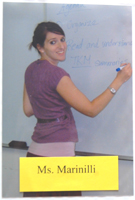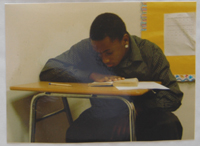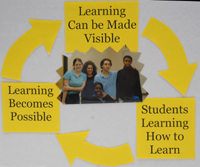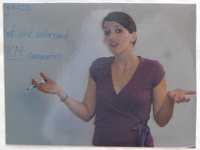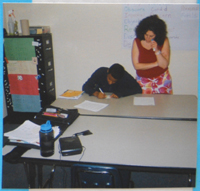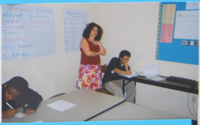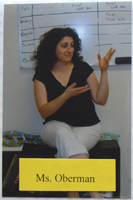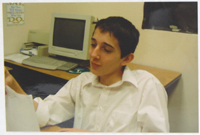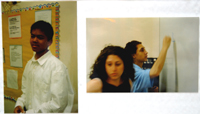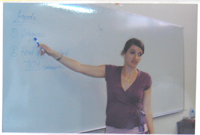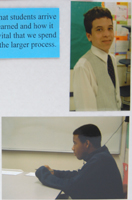As learning specialists at the Academy of the Pacific Rim Charter Public School (APR) in Hyde Park, Massachusetts, we do not create curriculum, themes, graded assignments or projects.
Documentation Examples > Documentation Exhibition
Making Learning Visible Makes Learning Possible
School: Academy of the Pacific Rim, Hyde Park, MA
1. Introduction
Our objectives as resource room teachers working with groups of five students or fewer, are focused around specific students? needs rather than a unit or topic. We see our students sixty minutes each school day and work with them towards academic success.
2. Initial Purpose
To examine how our verbal cues and responses motivate and/or discourage student learning and persistence.
3. Refined Purpose
We want to explore the procedures necessary for students to understand their own learning styles and to be academically successful. Our refined purpose comes from our discovery through documentation that student motivation is related to their own autonomy more than to the impact of verbal cues from learning specialists.
4. Motivation
Seventh grade students at APR read To Kill a Mockingbird, a challenging book that most students have a hard time comprehending and getting into at first. Mrs. Marinilli?s resource room is equipped with a mini basketball hoop and a Nerf basketball. She often uses these tools as well as others to get her students motivated and active in their learning. In the scenario to the right, students would answer a question after reading each chapter summary. In the middle or at the end of class, students would be able to take the same amount of basketball shots as questions that they had answered correctly. The student with the best score would win a small prize (i.e. candy, pencil, etc.).
Mrs. Marinilli: ?Ok. So, we are going to start off with the To Kill a Mockingbird summaries. We are going to read it together. How can we make sure that we are motivated and staying awake while we read??
JD: ?Basketball!?
CJ: ?Push-ups!?
Mrs. Marinilli: ?But how do we incorporate either push-ups or basketball while we read? Like after we read one summary??
JD: ?You get a shot!?
5. Organization
The seemingly simple process of doing a homework assignment is actually a series of at least eight tasks:
1) Hearing what the assignment is
2) Writing down the assignment
3) Having the proper materials
4) Making sure the materials travel to the proper destination
5) Knowing how to do (or at least begin) the assignment
6) Doing the assignment
7) Making sure the assignment travels back to school
8) Handing it in!
Students who struggle with organization, attention, and/or processing often require a substantial amount of time in order to successfully accomplish tasks.
An important task to accomplish is to ensure that students know what their homework assignments are. At times they leave class without a full grasp of what is expected of them. It can often take a significant amount of time to make sure students are on the same page. What follows is a snippet of a conversation that reflects the first and second steps of the homework process listed to the left.
?I know that it?s Friday afternoon. I know that you?re tired, but I also know that you need to know what your homework is? I?m trying to understand what happened [in science class]. He gave you these [articles]? He said read them both? He said read one? Were you in class? Do you have any idea? We?re going to say read both, that?s your homework, and you?re both going to write this down, and I?m going to give you both something to write it on.? ? Ms. Oberman, June 2, 2006
6. Process
A major challenge in the resource room is that students arrive from class often unaware of what they?ve learned and how it connects to the broader unit of study. It is vital that we spend class time on locating specific tasks within the larger process.
Ms. Oberman: ?Eric, do you remember the discriminant formula??
Eric: ?Probably not.?
Ms. Oberman: ?Do you want to take a guess? I?ll give you a hint. It?s part of the quadratic formula? You guys did this last week. You had a toolkit about it? the topic probably says discriminant.? ? June 2, 2006
7. Our Goals for Students
To learn how to learn
? Taking individual responsibility
? Knowing what steps to take
? Understanding learning style
8. Our Goals for Ourselves
To better structure class time and support
? Prioritizing student tasks/needs
? Supporting the curriculum vs. creating study skill-based lessons
9. Our Goals for Collaborating with Teachers
To more thoroughly differentiate instruction
? Considering different learning styles
? Accounting for varying pace and level of comprehension and performance


